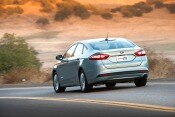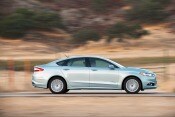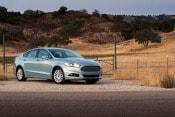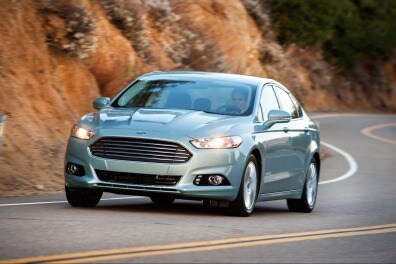2013 Ford Fusion Hybrid Sedan
2013 Ford Fusion Hybrid Sedan
(2.0L 4-cyl. Hybrid CVT Automatic)-
 View Photo
This Fusion Hybrid is slightly larger than the model it replaces, although it's hard to tell at first glance.
View Photo
This Fusion Hybrid is slightly larger than the model it replaces, although it's hard to tell at first glance.
-
 View Photo
Hard to deny that Ford did a fine job of styling the new Fusion.
View Photo
Hard to deny that Ford did a fine job of styling the new Fusion.
-
 View Photo
With EPA numbers in the high 40s, the Fusion Hybrid is about as fuel-efficient as you're going to get in a sedan of its size.
View Photo
With EPA numbers in the high 40s, the Fusion Hybrid is about as fuel-efficient as you're going to get in a sedan of its size.
View More Photos

A Hybrid Sedan That Doesn't Drive Like One
By Andrew Bornhop
Published: 10/22/2012
The original Honda Accord Hybrid — one of which averaged
an underwhelming 23.8 mpg during its 29,960-mile long-term stay at
Edmunds — certainly was a quick car, but it taught Honda a painful
lesson: People buy midsize hybrid sedans for fuel efficiency, not for
brisk acceleration.Published: 10/22/2012
Ford understands this, a point underscored by the new 2013 Fusion Hybrid and its class-leading EPA fuel-economy ratings of 47 city/47 highway mpg. That's nearly as efficient as a Toyota Prius, and significantly better than the first-generation Fusion Hybrid's 41 city/36 highway mpg. Moreover, it's a substantive step up from competitors such as the Toyota Camry Hybrid (43/42) and the Hyundai Sonata Hybrid (35/43).
With that in mind we had to wonder: Might the amazingly efficient new 2013 Ford Fusion Hybrid sacrifice every shred of driving enjoyment at the altar of fuel economy?
Let's find out.
More Normal Than You Might Think
As drivers of the previous Fusion Hybrid can attest, it's much like driving a standard car with a gasoline engine mated to a continuously variable transmission (CVT). Twist the conventional ignition key and you won't hear a starter crank the engine, but the instruments illuminate to indicate the car is ready for use. No engine is running, but when the gear selector is pulled back into Drive, the car will want to creep forward on battery power.
Acceleration from a stoplight is good, given the inherent torque of the electric motor. The car is also remarkably quiet inside, aided by triple-sealed doors and an active noise-cancellation system that works via the car's sound system. The transitions from electric power to gasoline and back (and any combination thereof) are seamless, although astute drivers can sense the gasoline engine kick in through slight vibrations in the steering wheel and pedals.
Subscribe to:
Post Comments (Atom)
No comments:
Post a Comment